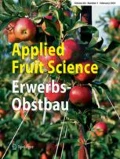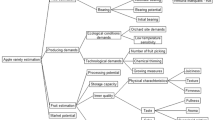Abstract
During the 2008–2010 growing seasons, an alternative ‘zero residue apple production system’ was compared with integrated apple production with cvs ‘Idared’, ‘Golden Delicious’, ‘Jonagold’ and ‘Gala’ in commercial orchards at several locations throughout Slovenia, using data envelopment analysis (DEA), and multi criteria assessment by an analytical hierarchical process (AHP). The principle of the ‘zero residue apple production’ is a combination of integrated (IP) and organic apple production. During the first 3 months of the growing season (1 April–30 June), pesticides used in IP with rapid degradation (8–10 applications) were used to control pests and diseases. During the second part of the season from 1 July to harvest, organic products (6–12 applications) were employed compared with 19–25 applications overall in IP. The goal of the alternative system was to reduce the amount of applied conventional pesticides by 40 % and to minimize pesticide residues in fruits to below the limit of 0.5 % of the legal maximum residue level (MRL) or below the residue concentrations of 0.005–0.01 mg/kg and to retain the high long-term level of yield, fruit quality, and net income per hectare. The number of pesticide residues was reduced from 4.2–5.5 in IP to 1.8–3.4 in zero residue cultivation, while 3 year average yields (class 1 fruit) were 4–9 % lower than in IP. The break even prices ranged from € 0.31 for Idared in IP, € 0.34 for ‘Elstar’ of both production systems to € 0.35/kg for zero residue cultivated ‘Golden Delicious’. Overall, a price increase of just € 0.02/kg for residue free apples would make this new ‘zero residue apple production’ profitable then representing a realistic alternative to the standard integrated apple production system.
Zusammenfassung
Über 3 Jahre (2008–2010) wurde der rückstandsfreie Apfelanbau bei den Sorten ‘Idared’, ‘Golden Delicious’, ‘Jonagold’, ‘Gala’ mit dem IP- Anbau auf Obstbaubetrieben in Slovenien mit Hilfe von statistischer und DEA-Analyse (data envelopment analysis) und multikriteriellen analytischen Hierarchieprozessen(AHP) untersucht. Das Prinzip des rückstandsfreien Apfelanbaus ist die Kombination des Intergrierten und ökologischen Anbaus. In den ersten 3 Monaten der Vegetationsperiode (1. April–30. Juni) wurden Pflanzenschutzmittel mit schneller Abbaurate aus Intergriertem Anbau mit 8–10 Maßnahmen und in der zweiten Vegetationshälfte vom 1. Juli bis zur Ernte Pflanzenschutzmittel (6–12 Maßnahmen) aus dem ökologischen Anbau eingesetzt. Das Ziel des rückstandsfreien Anbausystems ist es, erstens den konventionellen Pflanzenschutzmitteleinsatz unter 40 % zu reduzieren und zweitens die Pflanzenschutzmittelrückstände unter den zulässigen höchsten Rückstandswert (MRL-Maximum Residue Level) von 0,5 % bzw. unter die Rückstandskonzentration von 0,005–0,01 mg/kg zu senken. Die Zahl der Pflanzenschutzrückstände in den Äpfeln sanken von 4,2–5,5 im IP auf 1,8–3,4 im rückstandsfreien Apfelanbau. Die Voraussetzung für die Wirtschaftlichkeit des neuen rückstandsfreien Apfelanbaus ist ein dem IP-Anbau vergleichbarer Ertrag an qualitativ hochwertigen Äpfeln (Fruchtqualität und Netto-Einkommen). Die Kosten deckenden Erzeugerpreise reichten von € 0,31 für ‘Idared’ im IP, über € 0,34 für ‘Elstar’ beider Anbausysteme bis zu € 0,35/kg für rückstandsfreie ‘Golden Delicious’. Die Rentabilität des rückstandsfreien Anbaus war, aufgrund besserer Vermarktunschancen mit weniger Rückständen, trotz 4–9 % geringerer Erträge (HKl 1) als im IP mit dem Integrierten vergleichbar. Sie wäre bereits ab einem um € 0,02/kg höheren Preis für die rückstandsfreie Ware profitabel und könnte dann in Zukunft eine wirtschaftlich realistische Alternative zum Integrierten Anbau werden.


Similar content being viewed by others
References
Andre FJ (2009) Indirect elicitation of non-linear multi-attribute utility functions. A dual procedure combined with DEA Omega 37:883–895
Anonymus (2012) Erklärung der Institute für angewandte Forschung im Obstbau; Ist die Zukunft des Integrierten Obstanbaues in Mitteleuropa gefährdet? Mitt. OVR 67, 11, 1-2. http://www.esteburg.de/v1/uploads/Service/ErklaerungDerInstitute.pdf
Berrie AM, Cross JV (2005) Development of an integrated pest and disease management system for apples to produce fruit free from pesticide residues—aspects of disease control. IOBC/WPRS Bulletin 29(1):129–138
Berrie AM, Cross J (2012) Producing apples free of pesticide residues. IOBC-WPRS Bulletin 84:305–314
Bohanec M, Cortet J, Griffiths B, Žnidaršič M, Debeljak M, Caul S, Thompson J, Krogh PH (2007) A qualitative multi-attribute model for assessing the impact of cropping systems on soil quality. Pedobiologia 51:239–250
Bohanec M, Messean A, Scatasta S, Angevin F, Griffiths B, Krogh PH, Žnidaršič M, Džeroski S (2008) A qualitative multi-attribute model for economic and ecological assessment of genetically modified crops. Ecol Modelling 215:247–261
Carpani M, Bergez JM, Monod H (2012) Sensitivity analysis of a hierarchical qualitative model for sustainability assessment of cropping systems. Environ Modelling Software 27–28:15–22
Charnes A, Cooper WW (1962) Programming with linear fractional functionals. Nav Res Log 9(3–4):181–186
Charnes A, Cooper W, Rhodes E (1978) Measuring the efficiency of decision making units. Eur J Oper Res 2:429–444
Cross JV, Berrie AM (2001) Integrated pest and disease management in apple production. In: The Best Practice Guide for UK Apple Production, Department for Environment, Food & Rural Affairs (Defra), Horticulture Research International, Farm Advisory Services Team Ltd, ADAS, pp. 21–29
Cross JV, Berrie AM (2008) Eliminating the Occurrence of Reportable Pesticide Residues in Apples. Agricultural Engineering International: the CIGR Ejournal. Manuscript ALNARP 08 004. Vol. X
Dantsis T, Douma C, Giourga C, Loumou A, Polychronaki EA (2010) A methodological approach to assess and compare the sustainability level of agricultural plant production systems. Ecol Indic 10:256–263
Đatkov D, Effenberger M (2010) Data envelopment analysis for assessing the efficiency of biogas plants: Capabilities and limitations. J Process Energy Agric 14(1):49–53
Delate K, McKern A (2008) Organic Apple Systems: constraints and opportunities for producers in local and global markets: introduction to the colloquium. Hortscience 43(1):6–11
Girardin P, Bockstaller C, Werf H (2000) Assessment of potential impacts of agricultural practices on the environment: the AGRO*ECO method. Environ Impact Assess Rev 20:227–239
Jiang J, Wan N (2009) A model for ecological assessment to pesticide pollution management. Ecol Model 220:1844–1851
Jones AL, Ehret GR, El-Hadidi MF, Zabik MF, Cash JN, Johnson JW (1993) Potential for zero residue disease-control programs for fresh and processed apples using sulfur, fenarimol, and myclobutanil. Plant Dis 77:1114–1118
Lilienfeld A, Asmild M (2007) Estimation of excess water use in irrigated agriculture: a data envelopment analysis approach. Agr Water Manage 94:73–82
Mao W, Koo WW (1997) Productivity growth, technological progress, and efficiency change in Chinese agriculture after rural economic reforms: A DEA approach. China Econ Rev 8:157–174
Martić MM, Novaković MS, Baggia A (2009) Data envelopment analysis—basic models and their utilization. Organizacija 42:17–26
Mazzeto F, Bonera R (2003) MEACROS: a tool for multi-criteria evaluation of alternative cropping systems. Eur J Agron(18):379–387 Misra SK, Huang CL, Ott SL (1991) Consumer Willingness to Pay for Pesticide-Free Fresh Produce. Western Journal of Agricultural Economics 16(2):218–227
Montazar A, Behbahani SM (2007) Development of an optimised irrigation system selection model using analytical hierarchy process. Biosyst Eng 98:155–165
Nassiri SM, Singh S (2009) Study on energy use efficiency for paddy crop using data envelopment analysis (DEA) technique. Appl Energy 86:1320–1325
Pavlovič M, Cerenak A, Pavlovič V, Rozman Č, Bohanec M (2011) Development of DEX-HOP multi-attribute decision model for preliminary hop hybrids assessment. Computers Electron Agri 75:181–189
Pelzer E, Fortino G, Bockstaller C, Angevin F, Lamine C, Moonen C, Vasileiadis V, Guerin D, Guichard L, Reau R, Messean A (2012) Assessing innovative cropping systems with DEXiPM, a qualitative multi-criteria assessment tool derived from DEXi. Ecol Indic 18:171–182
Picazo-Tadeo AJ, Gomez-Limon JA, Reig-Martı́nez E (2011) Assessing farming eco-efficiency: a data envelopment analysis approach. J Environ Manag 92:1154–1164
Reig-Martı́nez E, Picazo-Tadeo AJ (2004) Analysing farming systems with data envelopment analysis: citrus farming in Spain. Agri Syst 82:17–30
Roosen J, Fox JA, Hennessy DA, Schreiber A (1998) Consumers’ valuation of insecticide use restrictions: an application to apples. J Agri Res Econ 23(2):367–384
Saaty TL (1980) The analytic hierarchy process. McGraw-Hill, New York
Saaty TL, Kearns K (1991) Analytical Planning; the Organization of Systems. Pergamon Press, Oxford. Russian edition: Paperback edition. RWS Publications, Pittsburgh
Sueyoshi T (1999) DEA non-parametric ranking test and index measurement: slack-adjusted DEA and an application to Japanese agriculture cooperatives. Omega 27:315–326
Tiwari DN, Loof R, Paudyal GN (1999) Environmental-economic decision-making in lowland irrigated agriculture using multi-criteria analysis techniques. Agri Syst 60:99–112
Triantaphyllou E, Mann SH (1994) An evaluation of the AHP and the revised AHP when the eigenvalue method is used under a continuity assumption. Computers Ind Eng 2(1):35–44
Wan N, Jiang J, Ji X, Deng J (2009) Application of analytic hierarchy process-based model of Ratio of Comprehensive Cost to Comprehensive Profit (RCCCP) in pest management. Ecol Econ 68:888–895
Weibel FP, Tamm L, Wyss E, Daniel C, Häseli A, Suter F (2007) Organic fruit production in Europe: successes in production and marketing in the last decade, perspectives and challenges for the future development. Acta Hortic 737:163–172
Zhang B, Zhang Y, Chen D, White RE, Li Y (2004) A quantitative evaluation system of soil productivity for intensive agriculture in China. Geoderma 123:319–331
Žnidaršič M, Bohanec M, Zupan B (2008) Modelling impacts of cropping systems: demands and solutions for DEX methodology. Eur J Oper Res 189:594–608
Author information
Authors and Affiliations
Corresponding author
Rights and permissions
About this article
Cite this article
Rozman, Č., Unuk, T., Pažek, K. et al. Multi Criteria Assessment of Zero Residue Apple Production. Erwerbs-Obstbau 55, 51–62 (2013). https://doi.org/10.1007/s10341-013-0186-y
Received:
Accepted:
Published:
Issue Date:
DOI: https://doi.org/10.1007/s10341-013-0186-y
Keywords
- Apple
- Production system
- Integrated production
- Zero residue
- Economics
- DEA analysis
- AHP assessment
- Sustainability




